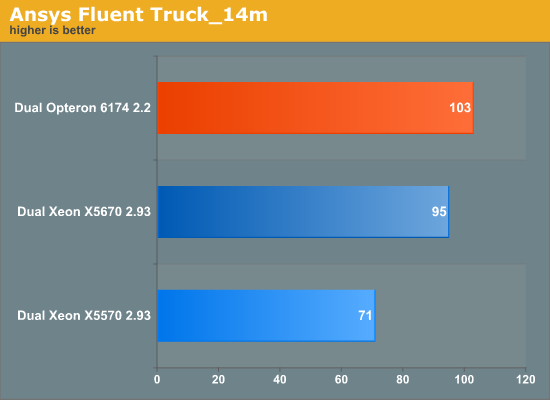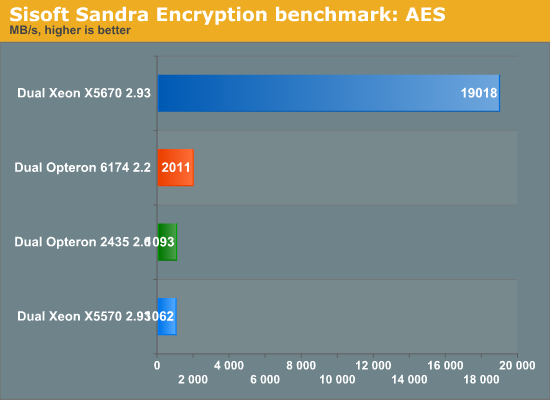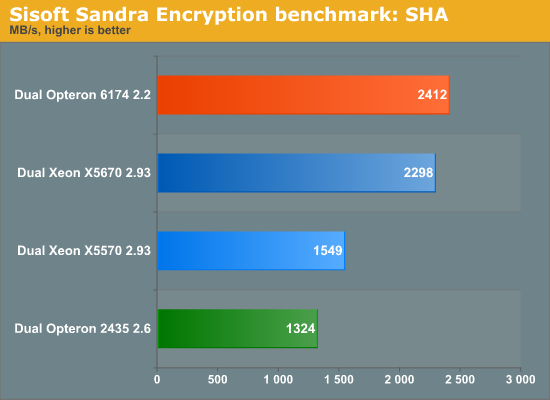AMD's 12-core "Magny-Cours" Opteron 6174 vs. Intel's 6-core Xeon
by Johan De Gelas on March 29, 2010 12:00 AM EST- Posted in
- IT Computing
HPC and Encryption Benchmarks
Just a few days prior to today's launch, we were able to get access to the benchmark numbers that Intel and AMD produced for LSDyna’s (Crash simulation) and Fluent (fluid dynamics) from Ansys. The first benchmark is the Ansys Fluent Truck_14 m benchmark.

The next one is LS Dyna “Neon refined revised”.

In both cases, the four memory channels and 12 core mix per CPU seem to pay off: AMD can beat Intel again in the HPC benchmarks, although the advantage is small.
Next we ran Sisoft Sandra 2010's encryption benchmark. Do remember that this is a completely synthetic benchmark. A 100% encryption performance advantage might translate in a very small performance advantage in a real world application. For example the code run on a website might only include a small part of encryption code.


Once the Xeon X5670's AES instructions can do their work, encryption is lightening fast. Here the new Xeon is 19 times faster than its older brother and 9 times faster than the best Opteron. Encryption can be broken up easily in smaller parts, it scales extremely well. The result is that the CPU with the most threads, the Xeon 5670 and Opteron 6174 easily outperform their older brothers in cryptographic hash functions.










58 Comments
View All Comments
Cogman - Tuesday, March 30, 2010 - link
It should be noted that newer nehelam based processors have specific AES encryption instructions. The benchmark where the xeon blows everything out of the water is likely utilizing that instruction set (though, AFAIK not many real-world applications do)Hector1 - Tuesday, March 30, 2010 - link
I read that Intel is expected to launch the 8-core Nehalem EX today. It'll be interesting to compare it against the 12-core Magny Cours. Both are on a 45nm process.spoman - Tuesday, March 30, 2010 - link
You stated "... that kind of bandwidth is not attainable, not even in theory because the next link in the chain, the Northbridge ...".How does the Northbridge affect memory BW if the memory is connected directly to the processor?
JohanAnandtech - Wednesday, March 31, 2010 - link
Depending on your definition, the nortbridge is in the CPU. AMD uses "northbride" in its own slides to refer to the part where the memory controller etc. resides.Pari_Rajaram - Tuesday, March 30, 2010 - link
Why don't you add STREAM and LINPACK to your benchmark suites? These are very important benchmarks for HPC.JohanAnandtech - Wednesday, March 31, 2010 - link
Stream... in the review.piooreq - Wednesday, March 31, 2010 - link
Hi Johan,For last few days I did several tests with Swingbench CC with similar database configuration but I achieved a bit different results, I’m just wondering what exactly settings you put for CC test itself. I mean about when you generate schema and data for that test? Thanks for answer.
JohanAnandtech - Thursday, April 1, 2010 - link
Your question is not completely clear to me. What is the info you would like? You can e-mail if you like at johanATthiswebsitePointcomzarjad - Wednesday, March 31, 2010 - link
Can't figure out if hyperthreading were enabled on Intels. Particularly interested in virtualization benchmark with hyperthreading both enabled and disabled. Also of interest would be an Office benchmark with a bunch of small VMs (1.5 to 2GB) to simulate VDI configuration.JohanAnandtech - Thursday, April 1, 2010 - link
Hyperthreading is always on. But we will follow up on that. A VDI based hypervisor tests is however not immediately on the horizon. The people of the VRC project might do that though. Google on the VRC project.